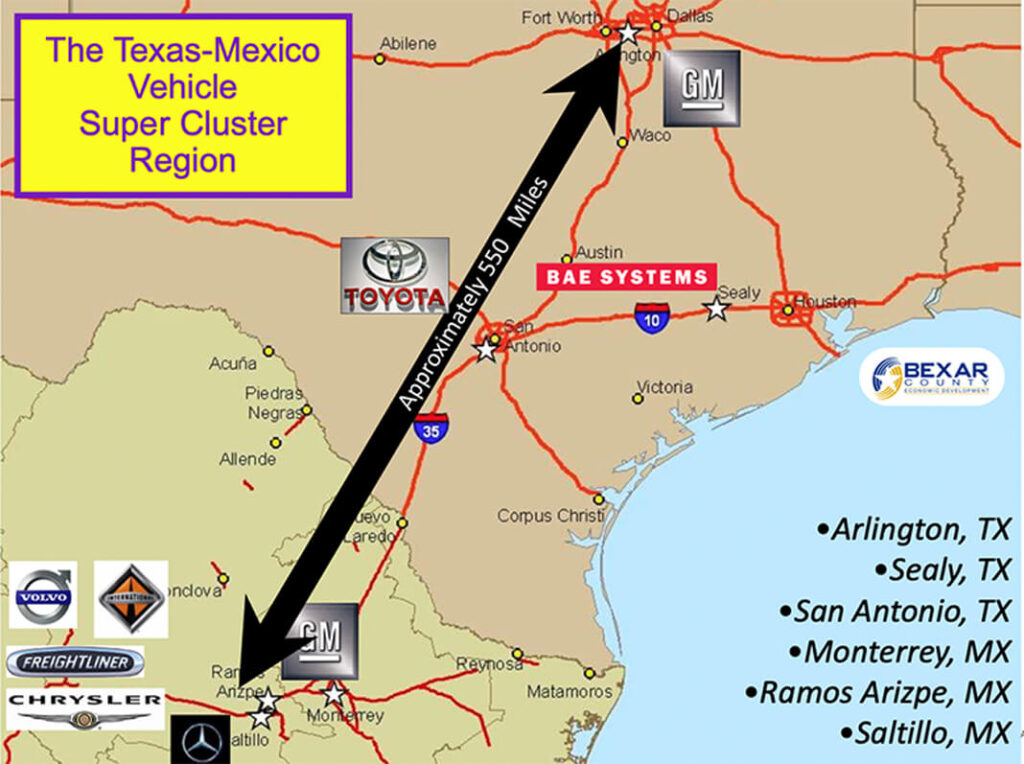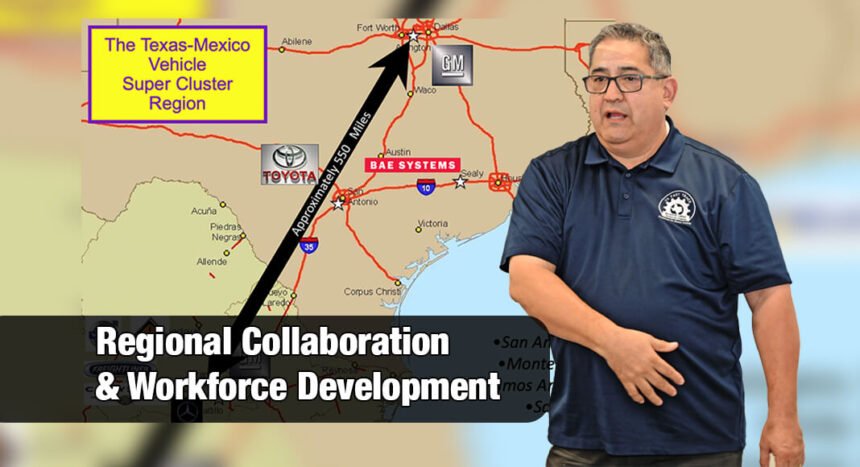Texas Border Business
By Roberto Hugo González
The Texas-Mexico Automotive Supercluster (TMASC) Regional Economic Development Meeting was held on Monday, May 19, 2025, at the University of Texas Rio Grande Valley (UTRGV) Center for Innovation and Commercialization in Weslaco. The event convened economic developers, local officials, industry leaders, and workforce professionals to explore the evolution of advanced manufacturing in Texas and northern Mexico. David Marquez, Executive Director of Economic and Community Development for Bexar County in San Antonio, Texas, served as the keynote speaker and presented a comprehensive analysis of the region’s automotive and manufacturing ecosystem.
Marquez began by reflecting on the formation of Bexar County’s economic development office in 2005, stating, “We created the office in 2005 when Toyota arrived in San Antonio. My commissioners gave me one order: maximize the economic benefit.” He noted that while many Texas counties had individual staff members handling economic development, Bexar County was the first to establish a formal office. “It’s been a lot of fun,” he added, “because that’s what development’s all about.”

The meeting centered on the concept of the automotive “supercluster”—a network of interconnected suppliers, assembly facilities, and supporting industries operating across geographic and political boundaries. “There’s no such thing in my view of an economic development strategy for this industry that revolves around one political subdivision,” Marquez said. “You have to think broader than that and collaboratively and collectively grow the industry in your region.”
According to Marquez, the Toyota plant in San Antonio played a pivotal role in shifting the regional economy. “We gave Toyota 2,300 acres in South County,” he explained. “It was their first-ever onsite supplier park, and to this day, it might still be the only one. But it came with risks. Toyota had to use all of its suppliers’ capacity. If the plant slows down, you can’t let your suppliers go out of business.”
Marquez emphasized the geography and logic behind regional supply chains. “A final assembly facility draws 80 percent of its components from within about 400 to 500 miles,” he said. “This is true for any final assembly facility in advanced manufacturing.” He added that the Texas-Mexico region functions similarly to other multi-state manufacturing zones in North America, despite the presence of a national border. “The industry has pretty well figured out how to work the border. It’s not ideal, but the benefits of proximity between northeastern Mexico and the U.S. market are impossible to ignore.”
Ron Garza, Associate Vice President for Workforce and Economic Development at UTRGV, opened the meeting by underscoring the importance of developing a clear understanding of the region’s supplier landscape. “We need our map and assessment of this,” Garza said. “We can’t advocate and talk very well about it if we can’t show it.”
Marquez agreed, citing Bexar County’s efforts to map its ecosystem through formal studies commissioned in 2008, 2012, and 2024. “This is all driven by data,” he said. “It’s not just about border crossings, but what items are crossing, what the tax regimes are, and how the supply chains are structured.”
During the presentation, Marquez walked the audience through the historical shifts in the U.S. automotive industry. “If my grandfather had bought a truck, it would’ve been made in the yellow dots around the Great Lakes. Then people moved south, and so did the industry. And starting in the 1990s, international companies—German, Korean, Japanese—entered North America and clustered in the southeast and into Mexico.” He added, “Our forecast in 2007 was that Texas and our area would be the next region for growth. That’s largely proven true.”
Marquez emphasized the importance of workforce readiness, describing Bexar County’s 10-week Fast Track training program. “Our program targets people who are unemployed, underemployed, reentry populations, and veterans,” he said. “We provide hands-on training to prepare them for maintenance technician roles. We have a 93 percent graduation rate and 85 percent placement rate, with wages averaging $27 per hour.”
He shared anecdotes illustrating the program’s impact. “We’ve had people come out of our homeless camp, and 10 weeks later, they’re making $60,000 a year. One of our graduates was a woman from Mexico who worked in the fast food industry. She joined the Fast Track program, and now she’s at Caterpillar, already climbing the ladder.”
Garza noted that UTRGV is evaluating ways to adopt similar models in the Valley. “We talked earlier about categorizing our suppliers not just by automotive but also by aerospace, healthcare, and other industries. That way, we can better understand our regional strengths.”
Throughout his remarks, Marquez repeatedly returned to the theme of collaboration. “When Tesla came to Austin, suppliers started showing up in Bexar County that we never even recruited,” he said. “That’s the nature of a cluster. They want to be near where the action is.” He emphasized that regional wins are not zero-sum. “Our wins are not your losses, and your wins are not our losses within this region. We lose when they go to Mississippi or Ohio or the central part of Mexico.”
He advocated for collective marketing strategies: “In the Southeast, four or five governors go overseas together to recruit companies. That’s a much stronger message. We need to fight together.”
Marquez also spoke frankly about infrastructure challenges. “We thought we built plenty of infrastructure around the Toyota plant, but we’re already struggling. It’s not on an interstate. And that’s something we have to address.”
In closing, he urged attendees to define their vision. “On the top of your page, write what your big win would be,” he told the audience. “And on the bottom, write what you have that could make that happen. That’s where your strategy begins.”
Marquez summarized the path forward: “If the region wants to win, you have to be intentional. That means understanding what your people can do, what the industry wants, and connecting those dots. Don’t get hung up on credentials—get them the skills.”
Garza added, “This meeting isn’t the end. It’s a launch point. We’re committed to building a more visible, more connected, and more competitive Valley.”













